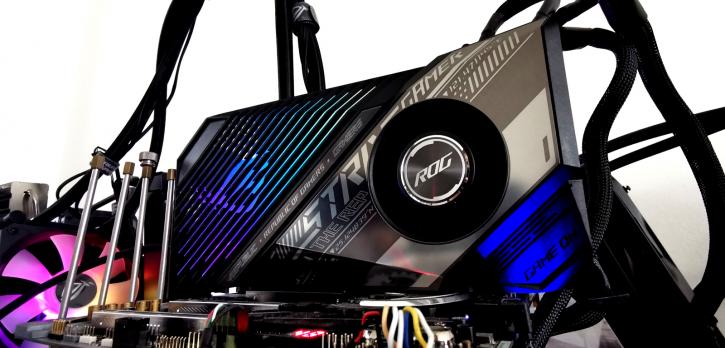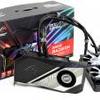Introduction
ASUS Radeon RX 6900 XT STRIX OC Liquid Cooled Review
Anyone in for some WAG (Wet Ass GPU)? ASUS just submitted their Radeon RX 6900 XT graphics card for review, and much like the 6800 XT, this one shows a bit more TLC as it has been fitted with hybrid cooling. Liquid cooling is being applied to the primary GPU area, and then a fan can cool down some of the additional components. The end result is a graphics card that is kept nicely moist and cool in an effort to give you silence and stamina. The card was fabbed around a custom PCB, premium components, a hybrid cooler, and increased clock frequencies, as well as an increased power limiter. This is one of the best performing acoustic products tied to a liquid cooling block and silent/performance operating modes. It has been a long wait for AMD and, sure, us. When the first NAVI based graphics cards were launched, they became well respected. The 5600 and 5700 series does offer some good performance. But during that launch, everybody was already talking about one thing, where is Big Navi? It's now November 2020 as we write this, and here we are, the world completely changed. Next to everything COVID-19 related, in the world of graphics technology, a new dynamic was added, Raytracing. Or, I should say DirectX Raytracing (DX-R). NVIDIA was pioneering two years ago with their RTX 2000 series already, and AMD made the call to delay that for the original Navi GPU. As the graphics landscape changed somewhere done the line, so this the roadmap for AMD change. Microsoft and Sony consoles embedded with AMD technology revealed that Raytracing was going to be supported. And that did set the trend for the desktop graphics card we see announced. AMD announced three graphics cards based on Big Navi; they all hold the very same GPU, just binned and somewhat 'weakened.' Interesting to learn is that the new GPUs are fabricated on an optimized 7nm node derived from TSMC. The cards will be PCIe 4.0 interface compatible. The number of hardware-accelerated RT cores is set up in a 1:1 creation towards the CU count. The cards released all fall into a high-end to the enthusiast-class category and are priced as such. The flagship Radeon Radeon RX 6900 XT is to cost 999 USD, the RX 6800 XT costs 649 USD, and the Radeon RX 6800 will cost 579 USD with performance levels matching the completion RTX 3070 running up-to the RTX 3090. It does that by many architectural improvements, but sure, increasing transistor real-estate comes into play as the shader processor count has nearly doubled up over last generational products. Three SKUs with a very similar design, all based on the same chip I stated, and that statement stands. The Radeon RX 6900 XT 16GB GDDR6 graphics card will get the full 80 CUs enabled. Multiply that with 64 shader units, and you'll count 5120 shading/stream processors. This card gets 16 GB of GDDR6 memory based on a 256-bit memory bus. So that means 512 GB/s of memory bandwidth and, in fact, would be equal to the bandwidth of the RTX 3070. The TDP listed is 300 watts. This fully enabled Big Navi based chip has a whopping 26.8 billion transistors. The clocks are the same as the 6800 XT at a 2250 GHz boost and 2015 MHz game clock. According to AMD (below), this card will battle with the GeForce RTX 3090. The card will become available on December 8th for 999 USD.
Radeon RX 6900 XT
The 6900 XT, which we review in this article, receives 80 activated CUs multiplied by 64 shader units is 5120 shading processors. This card gets 16 GB of GDDR6 memory based on a 256-bit memory bus, not to confuse the new GDDR6X memory NVIDIA uses for RTX 3080 and 3090. So that means 512 GB/s of memory bandwidth. The TDP listed is at 300 watts for this product. The 2250 GHz boost clock is high. Much like its two siblings, the card has that new 128 MB 'infinity cache' (we'll call it L3 cache). The card is to take on NVIDIA's finest (currently), the GeForce RTX 3090. In its reference design, this graphics card will cost you a sweet sum of 999 USD, which is a third cheaper than that GeForce RTX 3090.

| Desktop | ||||||||
| GPU | Stream Processors | RT Cores | Max Boost GPU clock (MHz) | RAM type | RAM volume (GB) | RAM bandwidth (GB/s) | RAM width | TDP (watts) |
| 6900 XT STRIX OC Liquid | 5120 | 80 | 2365 | GDDR6 | 16 | 512 | 256-bit | 300 |
| Radeon RX 6900 XT | 5120 | 80 | 2250 | GDDR6 | 16 | 512 | 256-bit | 300 |
| Radeon RX 6800 XT | 4608 | 72 | 2250 | GDDR6 | 16 | 512 | 256-bit | 300 |
| Radeon RX 6800 | 3840 | 60 | 2105 | GDDR6 | 16 | 512 | 256-bit | 250 |
| Radeon RX 5700 XT | 2560 | 1605 | GDDR6 | 8 | 448 | 256-bit | 225 | |
| Radeon RX 5700 | 2304 | 1465 | GDDR6 | 8 | 448 | 256-bit | 180 | |
| Radeon VII | 3840 | 1400 | HBM2 | 16 | 1024 | 4096-bit | 300 | |
| Radeon RX Vega 64 | 4096 | 1247 | HBM2 | 8 | 484 | 2048-bit | 295 | |
| Radeon RX Vega 56 | 3584 | 1156 | HBM2 | 8 | 410 | 2048-bit | 210 | |
| Radeon RX 590 | 2304 | 1469 | GDDR5 | 8GB | 256 | 256-bit | 185 |
All three cards released by AMD and their board partners will receive GDDR6 memory, 16 GB of them. Again that's for all three cards. So that means a 256-bit wide memory bus. However, AMD has got a few tricks up their sleeves architecture wise, as they added a big phat whopper of an L3 cache into the GPU. RDNA2 based graphics processors are DirectX Ultimate compatible, a naming placeholder for extra feature levels such as DirectX Raytracing (DXR), Variable Rate Shading (VRS), Mesh Shaders, and Sampler Feedback. But we have a lot to talk about and show you, next page, please.
ASUS RX 6900 XT STRIX OC Liquid Cooled
Delivered on our doorsteps is the RX 6900 XT STRIX OC LC. As stated, hybrid liquid-cooled, which makes the product unique, the primary components (GPU/VRM) get liquid-cooled by an RGB lit (AURA compatible) fans, based on a 240mm design radiator. The LC model is unique, alright, just 28cm in length, it is on a dual-slot design and is amped by dual 8-pin PCIe power connectors. You are going to notice a relatively tiny PCB concerning the impressive cooler. The RX 6900 XT graphics card has an outspoken black ROG design and obviously comes with a backplate. In the I/O area, the card includes two DisplayPort 1.4 ports, one HDMI 2.1, and a USB Type-C connector. Clock frequencies are 2135 MHz for the game clock and 2365 MHz for the max boost frequency, so that is an added 115 MHz on the turbo clock frequency. You can be certain that ASUS also has extended the board power allowance, as they recommend an 850W PSU to be paired with this product (that a recommendation for the entire PC, of course, nu just the graphics card). The 16GB GDDR6 memory clocks in at 2000 MHz (16 Gbps effective). Before we begin, we need to discuss pricing. The reference model will cost you roughly 1000 bucks; this LC version ROG STRIX I just checked, sits at 1500 USD. We'll talk more about this in conclusion. As always, we have a lot to talk about and show you; next page, please.


